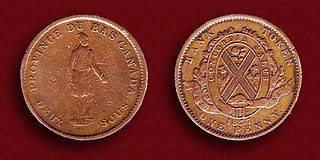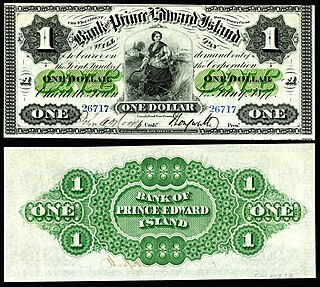Related Research Articles

The Canadian five-cent coin, commonly called a nickel, is a coin worth five cents or one-twentieth of a Canadian dollar. It was patterned on the corresponding coin in the neighbouring United States. It became the smallest-valued coin in the currency upon the discontinuation of the penny in 2013. Due to inflation, the purchasing power of the nickel continues to drop and currently the coin represents less than 0.5% of the country's lowest minimum hourly wage.

The Canadian fifty-cent coin is a Canadian coin worth 50 cents. The coin's reverse depicts the coat of arms of Canada. At the opening ceremonies for the Ottawa branch of the Royal Mint, held on January 2, 1908, Governor General Earl Grey struck the Dominion of Canada's first domestically produced coin. It was a silver fifty-cent coin bearing the effigy of King Edward VII.

In Canada, a penny is a coin worth one cent, or 1⁄100 of a dollar. According to the Royal Canadian Mint, the official national term for the coin is the "one-cent piece", but in practice the terms penny and cent predominate. Penny was likely readily adopted because the previous coinage in Canada was the British monetary system, where Canada used British pounds, shillings, and pence as coinage alongside U.S. decimal coins and Spanish milled dollars.

A pattern coin is a coin which has not been approved for release, but produced to evaluate a proposed coin design. They are often off-metal strike, to proof standard or piedforts. Many coin collectors collect and study pattern coins because of their historical importance. Many of the world's most valuable coins are pattern coins; nearly 25 of the pieces listed in 100 Greatest US Coins are pattern coins.

Canada has an extensive history with regard to its currencies. Prior to European contact, indigenous peoples in Canada used items such as wampum and furs for trading purposes, which continued when trade with Europeans began.
The dollar was the currency of New Brunswick between 1860 and 1867. It replaced the pound at a rate of 4 dollars = 1 pound and was equal to the Canadian dollar. The New Brunswick dollar was replaced by the Canadian dollar at par when New Brunswick entered the Canadian Confederation.
The dollar was the currency of Nova Scotia between 1860 and 1871. It replaced the Nova Scotian pound at a rate of 5 dollars = 1 pound and was consequently worth less than the Canadian dollar. The Nova Scotian dollar was replaced by the Canadian dollar at a rate of 73 Canadian cents = 75 Nova Scotian cents, thus maintaining the difference between the two currencies established in 1860.

The pound was the currency of the Canadas until 1858. It was subdivided into 20 shillings (s), each of 12 pence (d). In Lower Canada, the sou was used, worth 1⁄2 penny. Although the £sd accounting system had its origins in sterling, the Canadian pound was never at par with sterling's pound.
The coins of Canada are produced by the Royal Canadian Mint and denominated in Canadian dollars ($) and the subunit of dollars, cents (¢). An effigy of the reigning monarch always appears on the obverse of all coins. There are standard images which appear on the reverse, but there are also commemorative and numismatic issues with different images on the reverse.
One of the most profitable aspects of the Royal Canadian Mint (RCM) is its numismatic product line. The first numismatic coin from the RCM was arguably the 1935 dollar commemorating the Silver Jubilee of His Majesty King George V. Though intended for circulation, it was the first Canadian coin commemorating an event. The decision to issue this coin was made in October 1934 by then-Prime Minister R.B. Bennett. There were economic and patriotic motivations for the release of a silver dollar, including a hope to boost the silver mining industry. In future years, the silver dollar would have a more emotional meaning for many Canadians because it was also the first coin to have the Voyageur motif on its reverse.

As Newfoundland did not join Canada until 1949, it had its own currency for many decades. It adopted its own decimal currency in 1863. Compared to other pre-Confederation British colonies, it had a wide selection of decimal coinage. The most important coin in Newfoundland was the Spanish American dollar, therefore, the Newfoundland government set its dollar equal in value to this coin. The new decimal cent was equal to the British halfpenny and $4.80 was equal to one pound sterling.
The Canadian silver dollar was first issued by the Royal Canadian Mint in 1935 to commemorate the Silver Jubilee of King George V. The coin's reverse design was sculpted by Emanuel Hahn and portrays a voyageur and a person of Indigenous descent paddling a birch-bark canoe. The faint lines in the background represent the Northern Lights. The voyageur design was used on the dollar until 1986. It was then replaced with the 1987 Canadian 1-dollar coin. 1967 marked the end of the silver dollar as a business strike, or a coin issued for circulation. After 1967, the dollar coin was made of nickel, except for non-circulating commemorative issues for the collector market, which continue to contain silver.
The Ottawa Mint sovereign is a British one pound coin minted between 1908 and 1919 at the Ottawa Mint (known today as the Ottawa branch of the Royal Canadian Mint. This has augmented debate among Canadian numismatists because some view these pieces as Canadian while others view them as British and thus distinct from the decimal series of Canadian coinage. Since the opening of the Ottawa Mint, the Dominion of Canada’s government wanted to produce decimal gold coins. As it was a branch of the Royal Mint, it was obligated to mint sovereigns on request. When sovereigns were requested, it was usually for export causes.
One of the most highly profitable aspects of the Royal Canadian Mint’s enterprise is in its Numismatic product line. The euphoria surrounding the year 2000 led to the birth of the Millennium 25-cent coin program. The numismatic line included proof quality coins sold individually or as a complete set. This level of excess would come to signify the coming decade. The number of numismatic releases would increase on an annual basis starting in 2003. Numismatic three cents, five cents, and ten cents would be introduced, along with numismatic three dollars and eight dollars. Luxury coins would not be immune to the dramatic increases that ensued. Coins with face values of 250, 300 and 350 dollars would be introduced by 2006.
The Royal Canadian Mint has made coins with various themes. Most recently, ice hockey has been used for many numismatic releases. The first known ice hockey coin was for the 1988 Winter Olympics. Issued on February 25, 1986, the coin featured a goalie on the coin. Edge lettering was also used for the coin, the first time that it was used on silver coins.
Starting in 1997, the Royal Canadian Mint started to sell hockey medallions to the public. To commemorate the induction of Mario Lemieux in the Hockey Hall of Fame, a set was issued honouring all three inductees. One set was issued in Sterling Silver while another was issued in Nickel. The success of the release led to future issues.

The Prince Edward Island dollar was a unit of currency used in Prince Edward Island. The dollar replaced the Prince Edward Island pound in 1872 at a rate of 1 pound = 4.866 dollars. The dollar was subdivided into 100 cents.
The five-dollar gold piece was a gold Canadian coin that was struck for circulation from 1912 to 1914, consisting of 90% gold and 10% copper.
The ten-dollar piece was a gold Canadian coin that was struck for circulation from 1912 to 1914, consisting of 90% gold and 10% copper.
References
- ↑ https://en.numista.com/catalogue/pieces22006.html
- ↑ ’’Canadian Coins’’, 71st Edition, Volume One, Numismatic Issues, A Charlton Standard Catalogue, 2018, Toronto, p. 44
- ↑ A History of the Canadian Dollar, December, 2005]
- ↑ ’’Canadian Coins’’, 71st Edition, A Charlton Standard Catalogue, 2018, Toronto, p. 44
- ↑ ’’Canadian Coins’’, 71st Edition, A Charlton Standard Catalogue, 2018, Toronto, p. 44
- ↑ https://en.numista.com/catalogue/pieces22006.html